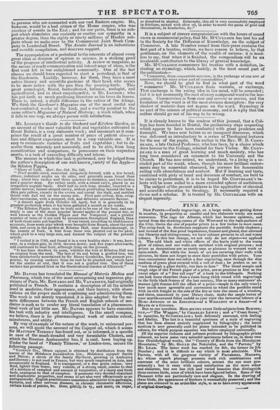Mr. LINDLEY'S Guide to the Orchard and Kitchen Garden, or
an account of the most valuable fruit and vegetables cultivated in Great Britain, is a very elaborate work ; and inasmuch as it com- prises the result of a great number of years of patient observa- tion and diligent experience, must be a very valuable one. It is easy to enumerate varieties of fruits and vegetables ; but to de- scribe them minutely and accurately, and to be able, from long consideration and comparison, to pronounce on their respective merits, is a task of exceeding difficulty and labour. The manner in which this task is performed, may be judged from the author's description of one well-known variety of the Apple— the Ribston Pippin.
" Glory of York. Hort . Soc. Cat. No. 946.
" Fruit middle-sized, somewhat irregularly formed, with a few broad, obtuse, indistinct angles on its sides, and generally more broad than long ; about two inches and three quarters in diameter, and two inches and a quarter deep. Eye rather small, with a closed calyx, placed in an irregularly angular basin. Stalk half an inch long, slender, inserted in a rather narrow, funnel-shaped cavity, seldom protruding beyond the base. Skin pale yellow, russety in the crown and round the stalk, and mottled thinly with dull red on the sunny side. Flesh pale yellow, firm, crisp. Juice saccharine, with a pungent, rich, and delicious aromatic flavour. " A dessert apple from October till April, but it is generally in its greatest perfection when it has been gathered a month or six weeks. "The Ribston Pippin may be truly said to be one of the best, and cer- tainly is one of the most popular dessert apples of the present day, as well known as the Golden Pippin and the Nonpareil; and a greater number of trees of it are sold by nurserymen throughout England, than of both those sorts put together. It was raised, according to traditionary accounts, from some pips which were brought from Rouen, about the year 1688, and sown in the garden at Ribston Hall, near Knaresborough, in the county of York. A tree from these was planted out in the park, which grew to a very large size, and formed the subject of the present article.
" I visited it in 1789, and found it in a very healthy state : it was, how- ever, in a violent gale, in 1810, thrown down; and, five years afterwards, still continued to bear fruit, although lying on the ground.
"It has been doubted by some, whether the tree at Ribston Hall was an original from the seed. The fact of its not being a grafted tree, has been satisfactorily ascertained by Sir Henry Goodricke, the present pro- prietor, by causing suckers from its root to be planted out, which have set the matter at rest, that it was not a grafted tree. One of these suckers has produced fruit in the Horticultural Garden at Chiswick."


























 Previous page
Previous page